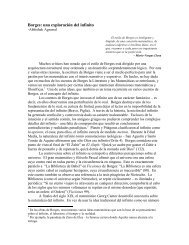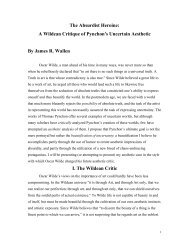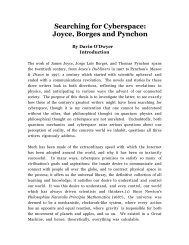And A Very Good Time It Was: A Short Life of ... - The Modern Word
And A Very Good Time It Was: A Short Life of ... - The Modern Word
And A Very Good Time It Was: A Short Life of ... - The Modern Word
You also want an ePaper? Increase the reach of your titles
YUMPU automatically turns print PDFs into web optimized ePapers that Google loves.
Joyce’s family was beginning to notice his genius, and his brother Stanislaus (two years<br />
younger than him and his first supporter) ignored his assignments at Belvedere and instead read<br />
what his brother did. Staislaus later claimed he, and not Nora’s Barnacle’s unpunctuated and<br />
rambling letters or a forgotten novel by Dujardin, gave Joyce the inspiration for the interior<br />
monologue. As children, while Joyce and Stanislaus fell asleep, they would talk and examine the<br />
intricacies <strong>of</strong> their sleepy speech. 14 Much <strong>of</strong> Stanislaus’ later resentment <strong>of</strong> his brother begins<br />
here, as Joyce was obviously the favored son: he was given special treatment at home around<br />
examination time and, considering the size <strong>of</strong> the family, he was still given his own room. <strong>And</strong>,<br />
less than a mile away from home, was the City <strong>of</strong> Dublin Public Library on Capel Street, whose<br />
stacks the young Joyce could credit as perhaps the true start <strong>of</strong> his independent education.<br />
In November, 1896, Joyce attended the hell-fire retreat that comprises most <strong>of</strong> chapter 3 <strong>of</strong><br />
Portrait, and for a brief time he had his own religious revival. But this new strain <strong>of</strong> piety did not<br />
last for long, and as he abandoned religion completely over the next few years, his faith now<br />
became centered on art. He wrote his first books, the prose sketches <strong>of</strong> Silhouettes and the poems<br />
<strong>of</strong> Moods. Both foretell, in the fragments that survive, his later journal <strong>of</strong> Epiphanies in prose, and<br />
the poetry that would become his first published book, Chamber Music.<br />
Peter Costello 15 places the date <strong>of</strong> Joyce’s first sexual experience in the second week <strong>of</strong><br />
August, 1898. After attending a play on South King Street, he came upon a prostitute. Beginning<br />
in that fall and probably for awhile after he met his wife six years later, he continued to see<br />
prostitutes. <strong>The</strong> experience seems to have the double-effect we would expect from Joyce—both<br />
disgust at the act but a necessary need for the experience; as Costello says, Joyce “was not a<br />
sentimentalist; he was in search <strong>of</strong> a deeper reality.” 16 Even here we can perhaps see Joyce’s<br />
aesthetic at work: though this “deeper reality” could be both pleasurable or unpleasant, there was<br />
no reason to judge (or avoid) the unpleasant for its own sake: life is life.<br />
Joyce read voraciously, and his most important discovery was the Norwegian playwright<br />
Henrik Ibsen, which Edna O’Brien says “ranks for Joyce as definitive as Saint Paul’s conversion<br />
on the way to Damascus.” 17 Barely known in Ireland (and where known, derided), Ibsen<br />
convinced Joyce <strong>of</strong> an art beyond the simple moralizing didacticism he’d grown up with. <strong>And</strong><br />
even though a census form states Joyce and Stanislaus could both speak and write Irish 18 , this is<br />
no more evidence <strong>of</strong> his devotion to the then-thriving Irish Revival than knowing Latin was<br />
indicative <strong>of</strong> his Catholic faith. Because just as Joyce could absorb, reject, and use to his own<br />
means the teachings <strong>of</strong> the Catholic Church, the same is true for the Irish Revival. <strong>And</strong> while<br />
Joyce and Ireland are indistinguishable now, the only way he could truly write about Ireland was<br />
by becoming a European, which required a different emphasis and a wholly personal (but at the<br />
same time universal) mythology.<br />
In the summer <strong>of</strong> 1897 he found the secular inspiration he needed in seeing a beautiful girl on<br />
Sandymount Strand. Described in Portrait, she was the symbol that freed him to follow art and<br />
nothing else:<br />
A girl stood before him in midstream, alone and still, gazing out to sea. She<br />
seemed like one whom magic had changed into the likeness <strong>of</strong> a strange and<br />
beautiful seabird. Her long slender bare legs were delicate as a crane’s and pure<br />
save where an emerald trail <strong>of</strong> seaweed had fashioned itself as a sign upon the<br />
flesh. Her thighs, fuller and s<strong>of</strong>t-hued as ivory, were bared almost to the hips,<br />
where the white fringes <strong>of</strong> her drawers were like feathering <strong>of</strong> s<strong>of</strong>t white down.<br />
Her slate-blue skirts were kilted boldly about her waist and dovetailed behind<br />
her. Her bosom was as a bird’s, s<strong>of</strong>t and slight, slight and s<strong>of</strong>t as the breast <strong>of</strong><br />
some dark-plumaged dove. But her long fair hair was girlish: and girlish, and<br />
touched with the wonder <strong>of</strong> mortal beauty, her face.





